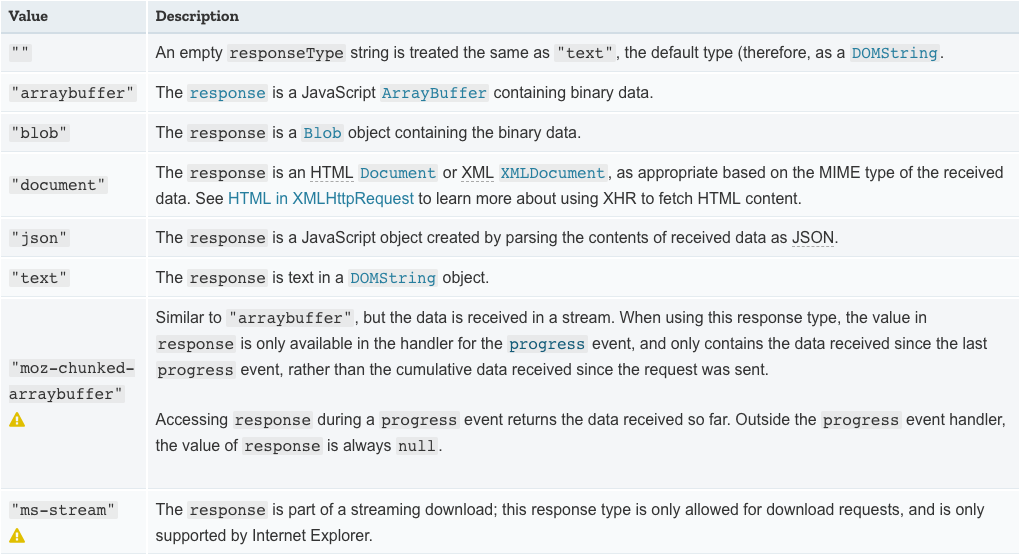关于XMLHttpRequest
开发者使用XMLHttpRequest对象与服务端进行交互(发送http请求、接受返回数据等),可以在不打断用户下一步操作的情况下刷新局部页面。XMLHttpRequest在Ajax中被大量使用。
XMLHttpRequest被应用时的处理机制

(图片来源:developer.mozilla.org)
关于Ajax
Ajax(切勿读为汉语化的“阿贾克斯”,应读英音/ˈeɪˌdʒæks/--“A寨科泗”。。)全称:Asynchronous JavaScript And XML (异步的JavaScript和XML)。
Ajax不仅可以只更新页面中的部分DOM,而且工作流程是异步的,不会阻塞其后面代码的正常执行。
在现代Web标准和实际应用中,Ajax正在逐步地被一些JavaScript框架封装好的方法和官方新的 Fetch API 所替代。
在正式介绍Ajax的使用前,我们认识下IE中的一个与XMLHttpRequest对象相应的概念(尽管后续它不会再被提及):
var ajax = new ActiveXObject('Microsoft.XMLHTTP');
深入了解XMLHttpRequest
// xhr对象的构造函数,用来实例化一个xhr对象。 XMLHttpRequest()
// xhr的常用属性 /* 1. onreadystatechange属性将指向一个事件处理函数,当xhr的readyState属性发生变化时被触发 */ xhr.onreadystatechange // usage: xhr.onreadystatechange = callback; /* 2. --ReadOnly-- readyState属性将返回当前请求的状态 */ xhr.readyState // usage: const xhr = new XMLHttpRequest(); console.log('UNSENT', xhr.readyState); // readyState will be 0 xhr.open('GET', '/api', true); console.log('OPENED', xhr.readyState); // readyState will be 1 xhr.onprogress = function () { console.log('LOADING', xhr.readyState); // readyState will be 3 }; xhr.onload = function () { console.log('DONE', xhr.readyState); // readyState will be 4 }; xhr.send(); // 具体示意如下图(插播一条广告):

/* 3. 获取或设置responseType(符合XMLHttpRequestResponseType规范的字符串) */ xhr.responseType // usage: const resType = xhr.responseType; // or xhr.responseType = 'json'; // XMLHttpRequestResponseType具体如下(插播第二条广告):

/* 4. --ReadOnly-- response返回响应体所包含的内容,内容格式由responseType决定 */ xhr.response // usage: const result = xhr.response; // 注:在responseType为''或者'text'时,response 和 responseText 可以相互替用 /* 5. --ReadOnly-- status属性将返回数字类型的http状态码 */ xhr.status // usage: const status = xhr.status; /* 6. --ReadOnly-- statusText将返回响应状态的文本描述,分别有''、'OK'、'Not Found' */ xhr.statusText // usage: const statusText = xhr.statusText; /* 7. timeout属性将指定请求自动终止的毫秒数,默认为零,即没有超时设置 */ xhr.timeout // usage: const xhr = new XMLHttpRequest(); xhr.open('GET', '/api', true); xhr.timeout = 5000; xhr.onload = function () { // Request finished. }; xhr.ontimeout = function (e) { // when XMLHttpRequest timed out ... }; xhr.send();
// xhr 的常用方法 /* 1. open 方法将创建一个新的http请求或者重新发送一个已有请求 */ xhr.open(method, url [, async, username, password]) // usage: xhr.open('GET', '/api'); /* 2. send 方法将向服务器发送一个请求 */ xhr.send(body) // usage: xhr.send(); /* 3. abort 方法将退出一个已有请求 */ xhr.abort() // usage: xhr.abort(); /* 4. XMLHttpRequestEventTarget.onload (注:不是xhr的方法,而是事件)*/ xhr.onload // usage: xhr.onload = callback; /* 5. setRequestHeader 可以设置一个http请求头的值 */ xhr.setRequestHeader(headername, value) // usage: const xhr = new XMLHttpRequest(); xhr.open('POST', '/api'); xhr.setRequestHeader("Content-Type", "application/x-www-form-urlencoded"); xhr.onreadystatechange = function() { //... }; xhr.send("foo=bar&lorem=ipsum");
实际编程中Ajax和XMLHttpRequest的应用
// 简单示例 const XHR = new XMLHttpRequest(); const handleReadyStateChange = () => { try { if (XHR.readyState === XHR.DONE) { if (XHR.status === 200) { console.log(XHR.response); } else { throw new Error('request failed!'); } } } catch (ex) { console.error('Caught Exception: ' + ex.message); } }; function generateRequest(type, api, body = null) { if (!XHR) { console.error('Cannot find XMLHttpRequest object!'); return false; } XHR.onreadystatechange = handleReadyStateChange; XHR.open(type, api); XHR.send(body); }
-- 待续